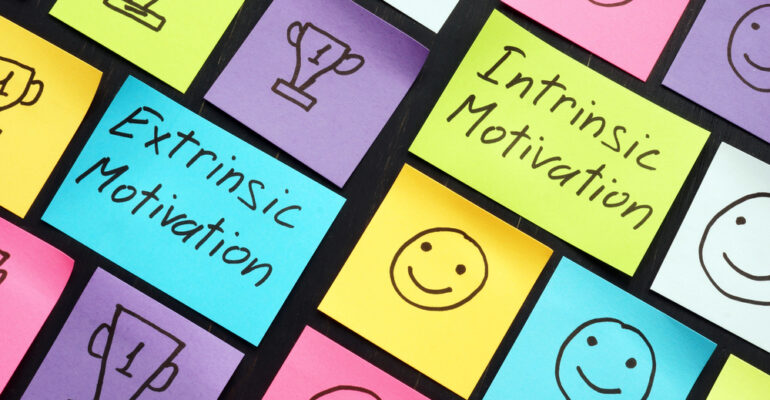Intrinsic Motivation and Behavior Change
Intrinsic motivation[1] refers to the drive to engage in an activity for its inherent satisfaction or enjoyment rather than for some separable consequence. This internal desire to act can significantly influence behavior change, making it a key factor for mental health professionals, educators, and individuals seeking personal development. Understanding intrinsic motivation can enhance our ability to facilitate lasting behavioral changes that promote well-being and fulfillment.
Understanding Intrinsic Motivation
Intrinsic motivation arises from within the individual and is characterized by:
- Personal Satisfaction: Individuals are motivated to engage in activities that they find enjoyable or fulfilling.[2] This satisfaction can stem from a variety of sources, including the challenge of the task, the joy of learning, or the pleasure of creative expression.
- Autonomy: When individuals feel that they have control over their actions and decisions, their intrinsic motivation tends to increase. Autonomy[3] fosters a sense of ownership and responsibility for one’s behavior, making individuals more likely to commit to change.
- Mastery: The desire to improve and master a skill can drive intrinsic motivation.[4] Engaging in activities that challenge one’s abilities can lead to a sense of achievement and competence, further reinforcing the desire to continue those behaviors.
- Connection: Building connections[5] with others through shared experiences can also enhance intrinsic motivation. The social aspect of engaging in activities that foster relationships can provide a strong motivation for change.
The Role of Intrinsic Motivation in Behavior Change
- Sustained Engagement: Research shows that intrinsic motivation is often more sustainable than extrinsic motivation.[6] When individuals are driven by personal satisfaction, they are more likely to persist in their efforts, even in the absence of external rewards. This persistence is crucial for long-term behavior change.
- Enhanced Learning: Intrinsically motivated individuals tend to engage more deeply with the tasks at hand. This depth of engagement enhances the learning process, allowing for a better understanding of the behavior change necessary for personal growth.
- Increased Resilience: Individuals who are intrinsically motivated are more likely to overcome setbacks and challenges. Their internal drive fosters resilience[7], allowing them to navigate difficulties without losing sight of their goals.
- Positive Emotional Outcomes: Engaging in activities for intrinsic reasons can lead to greater satisfaction and emotional well-being. The joy of pursuing interests and passions contributes to overall mental health and happiness.
Strategies to Enhance Intrinsic Motivation for Behavior Change
- Identify Personal Values: Encouraging individuals to reflect on their personal values can help them align their behaviors with what matters most to them. When individuals see the connection between their actions and their values, their intrinsic motivation can be strengthened.
- Set Intrinsically Motivated Goals: Help individuals set goals that focus on personal growth, enjoyment, or mastery rather than external rewards. Goals that resonate with intrinsic motivations foster a sense of fulfillment and encourage sustained engagement.
- Encourage Autonomy: Providing opportunities for individuals to make choices and take ownership of their actions can enhance intrinsic motivation. Allowing individuals to determine how they engage in behavior change fosters a sense of agency and empowerment.
- Promote Skill Development: Encouraging individuals to engage in activities that challenge them can enhance their sense of mastery. Skill development not only fosters intrinsic motivation but also contributes to self-efficacy, reinforcing the belief that they can successfully change their behavior.
- Cultivate a Supportive Environment: Creating an environment that encourages exploration, creativity, and connection can enhance intrinsic motivation. Supportive relationships and a positive atmosphere can provide individuals with the encouragement they need to pursue their interests and goals.
- Highlight the Joy of Learning: Emphasizing the process of learning and growth, rather than focusing solely on outcomes, can enhance intrinsic motivation.[8] When individuals see value in the learning journey itself, they are more likely to remain engaged and motivated.
Conclusion
Intrinsic motivation is a powerful force in the realm of behavior change. By understanding its role and employing strategies to enhance it, mental health professionals and individuals can foster sustainable changes that promote well-being. Cultivating intrinsic motivation not only leads to personal growth and fulfillment but also empowers individuals to take charge of their lives, making choices that align with their values and aspirations. By focusing on the joy of the journey rather than solely the destination, we can inspire lasting change that enhances the quality of life for ourselves and those we serve.
Are you interested in mastering everything about behavior change, behavior activation, consistency, sustainability, and motivation? If so, you’ll be excited to hear that SWEET Institute has declared the last quarter of 2024 the “Behavior Change Quarter.” You can choose from several learning opportunities, including a virtual conference, a 12-week weekly certificate course on behavior activation, and an 8-week master class certificate course on behavior change and motivation. Click on any of the options below to join us—we look forward to seeing you!
- Behavior Change and Motivation Master Class Certificate Course: 8 weeks, Wednesdays, 7-9 pm, September 11, 2024, through October 30, 2024.
- Behavior Modification Certificate Course: 12 weeks, Thursdays, 12-1 pm, September 19, 2024, through December 19, 2024.
- Behavior Activation Virtual Conference: 4 hours, Friday, October 18, 2024, from 9am-1 pm Eastern Time
[1] Fishbach, Ayelet, and Kaitlin Woolley. “The structure of intrinsic motivation.” Annual Review of Organizational Psychology and Organizational Behavior 9.1 (2022): 339-363.
[2] Cho, Heetae, and Weisheng Chiu. “The role of leisure centrality in university students’ self-satisfaction and academic intrinsic motivation.” The Asia-Pacific Education Researcher 30.2 (2021): 119-130.
[3] Meng, Liang, and Qingguo Ma. “Live as we choose: the role of autonomy support in facilitating intrinsic motivation.” International Journal of Psychophysiology 98.3 (2015): 441-447.
[4] Bieg, Sonja, Marion Reindl, and Markus Dresel. “The relation between mastery goals and intrinsic motivation among university students: a longitudinal study.” Educational psychology 37.6 (2017): 666-679.
[5] Fishbach, Ayelet, and Kaitlin Woolley. “The structure of intrinsic motivation.” Annual Review of Organizational Psychology and Organizational Behavior 9.1 (2022): 339-363.
[6] Morris, Laurel S., et al. “On what motivates us: a detailed review of intrinsic v. extrinsic motivation.” Psychological medicine 52.10 (2022): 1801-1816.
[7] Resnick, Barbara. “The relationship between resilience and motivation.” Resilience in aging: Concepts, research, and outcomes (2018): 221-244.
[8] Condry, John, and James Chambers. “Intrinsic motivation and the process of learning.” The hidden costs of reward. Psychology Press, 2015. 61-84.









